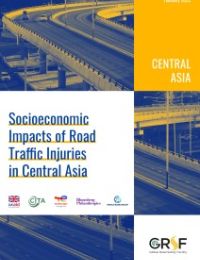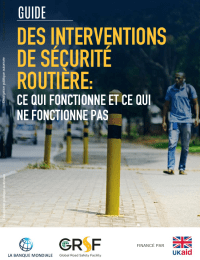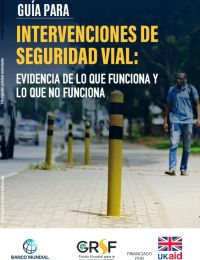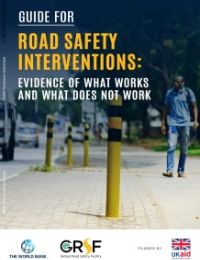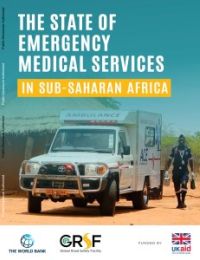Publications
21-30 of 68
-
-
-
- international literature and good practices on motorcycle safety;
- assessment of motorcycle crashes, regulations, risk exposure data, risk indicators in African countries (with more detailed analysis of Burkina Faso, Cameroon, Rwanda, and Uganda); and
- consultations with stakeholders.
-
-
-
Speed Management
Road Crash Trauma, Climate Change, Pollution and the Total Costs of Speed: Six Graphs That Tell the Story
July 2022

Walking is a predominant mode of travel in Addis Ababa representing more than half of the daily trips. The mild climate in Addis Ababa is conducive for this healthy and green mode of transport. However, sidewalks are often narrow, uneven, obstructed, or non-existent, causing discomfort and road safety risks to the most vulnerable road users: pedestrians. Studies done by the WHO and the Government showed that AA has disproportionately high pedestrian fatalities.
The study on Addis Ababa Sidewalk Safety and Improvement takes the approach of integrating digital technology and Urban Inventory in sidewalk surveys, applies the Global Walkability Index in sidewalk assessments, and adapts the global best practice to the local context. The Addis Ababa Sidewalk Design and Maintenance Guidelines seek to promote the development of quality pedestrian infrastructure and environments, based on the condition’s assessment and global best practices. The design specifications and visual rendering provide recommendations for the policy makers to consider when developing the City’s design and maintenance standards for urban roads, sidewalks, public spaces, and transit-oriented development, some of which are being carried out as part of the technical assistance program of the World-Bank financed Transport Systems Improvement Project (TRANSIP).
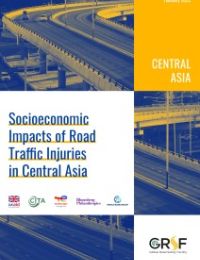
Road traffic injuries (RTIs) are well known to cause enormous human suffering in terms of both morbidity and mortality, and on a global scale. The economic dimension of the disease burden is far less well understood; but it is important to assess the size of the economic burden so that it can be considered when calculating the cost-benefit ratio of policies to tackle this problem. Because it is, in principle, and to some degree, an avoidable one.
This report focuses primarily on assessing various dimensions of the economic consequences of RTIs, as applied specifically to four Central Asian countries (Kazakhstan, Kyrgyzstan, Tajikistan, and Uzbekistan) – a part of the world in which there is still a major need to reduce RTIs.
This study shows that on top of the harm RTIs inflict upon human health, they also impose a considerable financial burden on health care systems. In 2016, the total estimated health costs of RTIs in these four countries was approximately Int$95 million, ranging from Int$2.8million in Tajikistan to Int$49.3 million in Kazakhstan. In Kazakhstan, the overall health costs resulting from RTIs were similar to the cumulative expenditure for rehabilitative and palliative care within the state-guaranteed basic package. The heavy financial burden on health care systems to manage RTIs in these countries adds weight to the urgency to increase preventive efforts by road safety policymakers, and should motivate appropriate organization of the post-crash response by health care system decision makers. The cost estimates discussed in this report indicate the potential for significant economic cost savings if both deaths and injuries from road crashes could be substantially reduced in these countries.

In developing countries with inadequate public transport and road infrastructure, motorcycles present a fast, cheap, and efficient transport alternative. Motorcycles are widely used in many African countries for personal and public transport, as well as for service delivery. In some African countries, motorized two and three-wheelers constitute the largest proportion of the motorized vehicle population. However, despite their benefits, motorcycles expose their riders and passengers to a high risk of serious injury or death in the event of crashes. Motorcycle safety is therefore a significant problem in Africa. On average, 22.5% of road traffic deaths in 2016 involved riders/passengers of two- and three-wheelers, according to the last data published by World Health Organization (WHO, 2018).
This research study presents comprehensive strategic recommendations on how to improve motorcycle safety in Africa. The study will serve as policy advice and technical assistance to the Bank’s regional member countries (RMCs). The study focuses on motorcycle safety conditions in Cameroon, Burkina Faso, Rwanda, and Uganda, where the use of motorcycles for daily activities is reputedly high. Recommendations are predicated on an examination of the major causes of motorcycle crashes and injuries, as well as an extensive body of knowledge from various sources, notably:

Les accidents de la route entraînent environ 1,35 million de décès et 50 millions de blessures dans le monde chaque année, dont plus de 90 % se produisent dans les pays à revenu faible ou intermédiaire (PRFI). Outre la douleur et la souffrance évidentes que cela inflige aux individus et aux communautés, ces décès et blessures représentent également un lourd fardeau financier, en particulier pour les PRFI, en ralentissant la croissance économique.
L’ampleur de la réponse actuelle à cette crise continue ne correspond pas à l’ampleur du problème. De plus, les ressources limitées consacrées à la sécurité routière sont souvent dépensées pour des interventions inefficaces ou sous-optimales. Bien que les connaissances en matière de sécurité routière se soient améliorées au cours des dernières décennies, il est encore nécessaire d'améliorer la prise de décision lors de la sélection et de l'application d'interventions efficaces basées sur des preuves. Les interventions efficaces sont celles qui réduisent les blessures mortelles et graves.
Le Global Road Safety Facility (GRSF) de la Banque mondiale a élaboré ce guide basé sur des preuves intitulé « Ce qui fonctionne et ce qui ne fonctionne pas » en matière de sécurité routière en réponse au besoin critique de solutions efficaces basées sur des preuves.
Ce guide a été préparé pour aider les lecteurs à comprendre que toutes les interventions en matière de sécurité routière ne sont pas également efficaces et que ce qui semble être des approches « de bon sens » pour choisir des interventions de sécurité routière ne sera souvent pas le meilleur choix. Bien que certaines apportent des avantages, d'autres ont des impacts très limités voire négatifs, malgré le fait qu'elles soient couramment – et à tort – recommandées ou acceptées. Le guide offre une gamme de recommandations en mettant l'accent sur les interventions dans les PRFI, bien que les informations puissent également être pertinentes pour tous les pays. Le contenu sera précieux pour ceux qui travaillent sur la sécurité routière au niveau des politiques ou des praticiens, y compris les chefs d'équipe techniques de la Banque mondiale et d'autres personnes cherchant à établir, développer ou améliorer des programmes de sécurité routière dans les PRFI.
Le guide situe les connaissances sur les interventions basées sur des preuves dans un contexte de « Système sûr », en fournissant des conseils sur chacun des piliers du Système sûr (gestion de la sécurité routière, routes sûres, vitesses sûres, véhicules sûrs, usagers de la route sûrs et soins post-accident) tout en reconnaissant que les solutions basées sur des preuves doivent être tirées de tous les piliers pour produire des résultats efficaces en matière de sécurité routière. Au cœur de ce document se trouve un tableau récapitulatif avec un aperçu des interventions bénéfiques et non bénéfiques basées sur des preuves scientifiques solides. Cela est suivi d'informations plus détaillées, y compris des études de cas et des références à la base de preuves pour soutenir le résumé.
De nombreuses interventions sûres sur les routes sont recommandées pour adoption, y compris les transports publics intégrés, les systèmes de barrières latérales et centrales, les médianes, les infrastructures pour soutenir une vitesse de fonctionnement appropriée pour les usagers de la route, les giratoires, la séparation de niveau et les interventions pour réduire l'exposition aux risques aux intersections, les trottoirs et passages piétons, les installations séparées pour les bicyclettes et les motocyclettes, et les panneaux de signalisation et le marquage au sol (y compris le marquage tactile-audio). Certaines de ces interventions sont très efficaces, avec une réduction allant jusqu'à 70 ou 80 % des décès et des blessures graves (par exemple, les barrières de sécurité et les giratoires).
Diverses interventions liées à la vitesse produisent également des avantages significatifs, certaines étant capables de presque éliminer les décès et les blessures graves. Des exemples d'interventions efficaces sur la vitesse incluent le ralentissement de la circulation (y compris les ralentisseurs et les chicanes), les giratoires, les intersections et passages surélevés, les traitements d'entrée, les limites de vitesse inférieures (y compris les zones de 30 km/h (20 mph) pour les piétons) et les radars automatiques.
Diverses interventions basées sur les usagers de la route ont été mises en œuvre au fil des ans, avec des exemples efficaces incluant une pratique supervisée extensive sur la route et/ou des systèmes de permis de conduire gradués dans le cadre du système de délivrance des permis de conduire, une augmentation de l'âge d'admissibilité au permis de conduire, une formation et des tests de perception des dangers, l'éducation et les campagnes publiques dans le cadre d'une stratégie intégrée (en particulier la communication sur l'application de la loi pour augmenter la dissuasion générale), l'application de la loi, les pénalités, les verrous d'alcool, la surveillance de la fatigue et de la vitesse, et l'augmentation des taux de port du casque.
Les principales interventions basées sur les véhicules comprennent l'application de normes minimales de sécurité des véhicules et les évaluations des véhicules (via le Programme mondial d'évaluation des voitures neuves, ou « NCAP »), les ceintures de sécurité, l'entretien périodique des véhicules, les feux diurnes, les pare-chocs arrière sur les camions, le contrôle électronique de la stabilité et d'autres technologies avancées pour les véhicules.
Les soins post-accident améliorés peuvent également produire de meilleurs résultats en matière de sécurité routière, y compris des systèmes pour améliorer le temps de réponse d'urgence, de meilleurs soins d'urgence, une amélioration des compétences en premiers secours pour le public et une amélioration des soins hospitaliers.
Tout aussi important, le rapport identifie également des exemples clairs où les interventions ne sont pas efficaces. Les pires de ces interventions sont celles qui augmentent le risque. Cela inclut l'augmentation de la vitesse de déplacement sans améliorer la qualité des infrastructures de sécurité, la plupart des formes d'éducation et de formation des conducteurs et motocyclistes après l'obtention du permis, et de nombreuses (mais pas toutes) formes d'éducation des conducteurs en milieu scolaire (telles que celles qui cherchent à améliorer les compétences de conduite). L'augmentation du risque est généralement due au fait que ces initiatives augmentent le niveau de confiance, conduisant à une prise de risque accrue. D'autres interventions qui n'ont pas démontré de bénéfices pour la sécurité doivent être évitées. Cela inclut les systèmes de permis via demande ou paiement, les programmes de formation ou d'éducation dans les écoles visant à améliorer les connaissances en matière de sécurité routière (y compris les visites ad hoc d'experts ou d'enthousiastes en sécurité routière), et les campagnes d'éducation menées isolément.
Il existe des interventions alternatives efficaces pour chacune de celles-ci comme décrit dans ce document, et elles devraient être appliquées à la place. Il est extrêmement important que les ressources ne soient pas gaspillées sur des interventions inefficaces au nom de la sécurité routière, mais plutôt que des interventions de sécurité routière basées sur des preuves soient mises en œuvre.
Il existe une variété de documents disponibles sur la question de l'efficacité des interventions en matière de sécurité routière, dont beaucoup sont référencés ici. Cependant, il existe quelques points clés de différence et de valeur ajoutée dans ce guide, y compris une synthèse des preuves sur un large éventail d'interventions et un contraste entre les interventions efficaces et non efficaces, permettant aux lecteurs de comparer les options. Lorsqu'une intervention non efficace est identifiée, des interventions efficaces viables sont fournies, soutenant ainsi la prise de décision. Le guide offre également des conseils directs à ceux qui travaillent dans les PRFI, en s'appuyant sur des sources d'information clés lorsque celles-ci sont disponibles. De manière importante, des preuves concises mais robustes sont fournies pour chacun des piliers du Système sûr.
Il est nécessaire de continuer à renforcer la base de connaissances sur les interventions efficaces en matière de sécurité routière, en particulier dans les PRFI où il existe un certain nombre de lacunes en matière de connaissances. Le contenu de ce guide représente un résumé utile et à jour des connaissances actuelles pour application.

Acidentes de trânsito resultam em cerca de 1,35 milhão de mortes e 50 milhões de feridos no mundo todo por ano, com mais de 90% deles ocorrendo em países de renda média e baixa (LMICs). Além da dor e do sofrimento óbvios que isso inflige a indivíduos e comunidades, essas mortes e ferimentos também representam um grande fardo financeiro, especialmente para os LMICs, ao desacelerar o crescimento econômico.
A escala da resposta atual a essa crise contínua não corresponde ao tamanho do problema. Além disso, recursos limitados de segurança no trânsito são frequentemente gastos em intervenções ineficazes ou abaixo do ideal. Embora o conhecimento sobre segurança no trânsito tenha melhorado nas últimas décadas, ainda há necessidade de melhorar a tomada de decisões ao selecionar e aplicar intervenções eficazes de segurança no trânsito baseadas em evidências. Intervenções eficazes são aquelas que reduzem ferimentos fatais e graves.
O Global Road Safety Facility (GRSF) do Banco Mundial desenvolveu este guia baseado em evidências sobre "O que funciona e o que não funciona" na segurança no trânsito em resposta à necessidade crítica de soluções eficazes baseadas em evidências.
Este guia foi preparado para ajudar os leitores a entender que nem todas as intervenções de segurança no trânsito são igualmente eficazes e que o que parecem ser abordagens de "senso comum" para selecionar intervenções de segurança no trânsito muitas vezes não serão as melhores. Embora algumas forneçam benefícios, outras têm impactos muito limitados ou mesmo negativos, apesar de serem comumente — e erroneamente — recomendadas ou aceitas. O guia oferece uma série de recomendações com foco em intervenções em países de baixa e média renda, embora as informações também possam ser relevantes para todos os países. O conteúdo será valioso para aqueles que trabalham com segurança no trânsito em níveis de política ou profissional, incluindo líderes de equipe técnica do Banco Mundial e outros que buscam estabelecer, expandir ou melhorar programas de segurança no trânsito em países de baixa e média renda.
O guia define o conhecimento sobre intervenções baseadas em evidências dentro de um contexto de "Sistema Seguro", fornecendo conselhos sobre cada um dos pilares do Sistema Seguro (gestão de segurança no trânsito, estradas seguras, velocidades seguras, veículos seguros, usuários seguros das estradas e cuidados pós-acidente), ao mesmo tempo em que reconhece que soluções baseadas em evidências devem ser extraídas de todos os pilares para produzir resultados eficazes de segurança no trânsito. No centro deste documento está uma tabela de resumo com uma visão geral de intervenções benéficas e não benéficas com base em evidências científicas sólidas. Isso é seguido por informações mais detalhadas, incluindo estudos de caso e referências à base de evidências para dar suporte ao resumo.
Muitas intervenções rodoviárias seguras são recomendadas para adoção, incluindo transporte público integrado, sistemas de barreiras centrais e de beira de estrada, medianas, infraestrutura para dar suporte à velocidade operacional apropriada para usuários da estrada, rotatórias, separação de nível e intervenções para reduzir a exposição ao risco em cruzamentos, caminhos e travessias de pedestres, instalações separadas para bicicletas e motocicletas e sinais de trânsito e marcação de linhas (incluindo marcação de linhas áudio-táteis). Algumas delas são altamente eficazes, com uma redução de até 70 ou 80 por cento em fatalidades e ferimentos graves (por exemplo, barreiras de segurança e rotatórias).
Várias intervenções relacionadas à velocidade também produzem benefícios significativos, com algumas capazes de quase eliminar mortes e ferimentos graves. Exemplos de intervenções eficazes de velocidade incluem acalmia de tráfego (incluindo lombadas e chicanes), rotatórias, cruzamentos e cruzamentos elevados, tratamentos de entrada, limites de velocidade mais baixos (incluindo zonas de 30 km/h (20 mph) para pedestres) e radares de velocidade.
Uma variedade de intervenções baseadas em usuários de estradas foram implementadas ao longo de muitos anos, com exemplos eficazes incluindo ampla prática supervisionada na estrada e/ou sistemas de licenciamento graduados como parte do sistema de licenciamento de motoristas, aumento da idade para elegibilidade da carteira de motorista, treinamento e teste de percepção de risco, educação pública e campanhas como parte de uma estratégia integrada (especialmente comunicando a fiscalização para aumentar a dissuasão geral), fiscalização, penalidades, bloqueios de álcool, monitoramento de fadiga e velocidade e aumento das taxas de uso de capacetes.
As principais intervenções baseadas em veículos incluem a aplicação de padrões mínimos de segurança de veículos e classificações de veículos (por meio do Global New Car Assessment Program, ou “NCAP”), cintos de segurança, manutenção periódica de veículos, luzes diurnas, protetores contra atropelamento em caminhões, Controle Eletrônico de Estabilidade e outras tecnologias avançadas de veículos.
O atendimento pós-acidente aprimorado também pode produzir melhores resultados de segurança nas estradas, incluindo sistemas para melhorar o tempo de resposta a emergências, melhor atendimento de emergência, melhores habilidades de primeiros socorros para o público e melhor atendimento hospitalar.
Igualmente importante, o relatório também identifica exemplos claros em que as intervenções não são eficazes. As piores são as intervenções que aumentam o risco. Isso inclui aumentar a velocidade de viagem sem melhorar a qualidade da infraestrutura de segurança, a maioria das formas de educação e treinamento de motoristas e passageiros pós-licença e muitas (mas não todas) formas de educação regular de motoristas em escolas (como aquelas que buscam aumentar as habilidades de manuseio de carros). O aumento do risco ocorre normalmente porque tais iniciativas aumentam o nível de confiança, levando a um aumento na tomada de riscos. Outras intervenções que não têm benefícios de segurança demonstrados devem ser evitadas. Isso inclui esquemas de licença por meio de solicitação ou pagamento, programas de treinamento ou educação dentro das escolas que visam melhorar o conhecimento sobre segurança no trânsito (incluindo visitas ad hoc de especialistas ou entusiastas em segurança no trânsito) e campanhas educacionais conduzidas isoladamente.
Existem intervenções alternativas eficazes para cada uma delas, conforme descrito neste documento, e elas devem ser aplicadas em vez disso. É extremamente importante que os recursos não sejam desperdiçados em intervenções ineficazes em nome da segurança no trânsito, mas sim que intervenções de segurança no trânsito baseadas em evidências sejam empregadas.
Há uma variedade de documentos disponíveis sobre a questão da eficácia das intervenções de segurança no trânsito, muitos dos quais são referenciados aqui. No entanto, há alguns pontos-chave de diferenças e valor agregado neste guia, incluindo uma síntese das evidências sobre uma ampla gama de intervenções e um contraste entre intervenções eficazes e não eficazes, permitindo que os leitores comparem as opções. Onde intervenções não efetivas são identificadas, intervenções efetivas viáveis são fornecidas, apoiando assim a tomada de decisões. O guia também fornece aconselhamento direto para aqueles que trabalham em países de baixa e média renda, com base em fontes-chave de informação, onde isso está disponível. É importante ressaltar que evidências concisas, porém robustas, são fornecidas em cada um dos pilares do Sistema Seguro.
Há uma necessidade de continuar construindo a base de conhecimento sobre intervenções efetivas de segurança no trânsito, particularmente em países de baixa e média renda, onde há uma série de lacunas no conhecimento. O conteúdo deste guia representa um resumo útil e atualizado do conhecimento atual para aplicação.
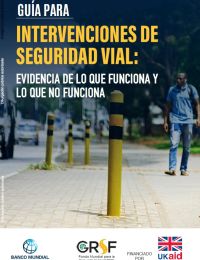
Durante muchos años se han implementado diversas intervenciones basadas en los usuarios de las vías, con ejemplos efectivos que incluyen prácticas supervisadas en la vía y/o sistemas de licencias graduales como parte del sistema de licencias de conducir, aumento de la edad para la obtención de la licencia de conducir, capacitación y pruebas de percepción de riesgos, educación pública y campañas como parte de una estrategia integrada (especialmente la comunicación de la aplicación de la ley para aumentar la disuasión general), aplicación de la ley, sanciones, dispositivos de bloqueo de alcoholemia, monitoreo de fatiga y velocidad y mayores tasas de uso del casco.
Las intervenciones clave basadas en vehículos incluyen la aplicación de estándares mínimos de seguridad y calificaciones de vehículos (a través del Programa Global de Evaluación de Autos Nuevos o “NCAP”), cinturones de seguridad, mantenimiento periódico de vehículos, luces de circulación diurna, protectores antiempotramiento en camiones, control electrónico de estabilidad y otras tecnologías avanzadas para vehículos.
Una mejor atención posterior a un accidente también puede producir mejores resultados en materia de seguridad vial, incluidos sistemas para mejorar el tiempo de respuesta ante emergencias, mejor atención de emergencia, mejores habilidades de primeros auxilios para el público y mejor atención hospitalaria.
Igualmente importante es que el informe también identifica ejemplos claros en los que las intervenciones no son efectivas. Las peores de ellas son las intervenciones que aumentan el riesgo. Entre ellas se encuentran el aumento de la velocidad de los viajes sin mejorar la calidad de la infraestructura de seguridad, la mayoría de las formas de educación y formación para conductores y motociclistas posteriores a la obtención de la licencia y muchas (pero no todas) formas de educación para conductores en las escuelas (como las que buscan mejorar las habilidades de manejo del automóvil). El aumento del riesgo se debe normalmente a que dichas iniciativas aumentan el nivel de confianza, lo que lleva a un aumento de la asunción de riesgos. Hay que evitar otras intervenciones que no han demostrado tener beneficios en materia de seguridad, como los programas de licencias mediante solicitud o pago, los programas de formación o educación en las escuelas que tienen como objetivo mejorar el conocimiento de la seguridad vial (incluidas las visitas ad hoc de expertos o entusiastas de la seguridad vial) y las campañas de educación realizadas de forma aislada.
Existen intervenciones alternativas eficaces para cada una de estas, como se describe en este documento, y se deberían aplicar en su lugar. Es extremadamente importante que no se desperdicien recursos en intervenciones ineficaces en nombre de la seguridad vial, sino que se empleen intervenciones de seguridad vial basadas en la evidencia.
Hay una variedad de documentos disponibles sobre el tema de la eficacia de las intervenciones de seguridad vial, muchos de los cuales se citan aquí. Sin embargo, esta guía contiene algunos puntos clave que diferencian y aportan valor añadido, como una síntesis de la evidencia sobre una amplia gama de intervenciones y un contraste entre intervenciones eficaces e ineficaces, lo que permite a los lectores comparar las opciones. Cuando se identifican intervenciones ineficaces, se ofrecen intervenciones eficaces viables, lo que respalda la toma de decisiones. La guía también ofrece asesoramiento directo a quienes trabajan en países de ingresos bajos y medios, basándose en fuentes de información clave cuando están disponibles. Es importante destacar que se ofrece evidencia concisa pero sólida sobre cada uno de los pilares del Sistema Seguro.
Es necesario seguir construyendo la base de conocimientos sobre intervenciones eficaces en materia de seguridad vial, en particular en los países de ingresos bajos y medios, donde hay una serie de lagunas en el conocimiento. El contenido de esta guía representa un resumen útil y actualizado del conocimiento actual para su aplicación.

Road traffic crashes result in an estimated 1.35 million deaths and 50 million injuries worldwide per year with over 90 percent of these occurring in Low-Middle Income Countries (LMICs). Aside from the obvious pain and suffering this inflicts on individuals and communities, these deaths and injuries also place a large financial burden particularly on LMICs, by slowing economic growth.
The scale of the current response to this continuing crisis does not match the size of the problem. In addition, limited road safety resources are often expended on ineffective or suboptimal interventions. While road safety knowledge has improved over recent decades, there is still a need to improve decision making when selecting and applying effective evidence-based road safety interventions. Effective interventions are those that reduce fatal and serious injuries.
The World Bank's Global Road Safety Facility (GRSF) has developed this evidence-based guide on “What Works and What Does Not Work” in road safety in response to the critical need for effective evidence-based solutions.
This guide has been prepared to help readers understand that not all road safety interventions are equally effective and that what appear to be “common-sense” approaches to selecting road safety interventions will often not be the best. Although some provide benefits, others have very limited or even negative impacts, despite being commonly—and mistakenly—recommended or accepted. The guide offers a range of recommendations with a focus on interventions in LMICs, although the information may also be of relevance to all countries. The contents will be valuable to those working on road safety at policy or practitioner levels, including World Bank technical team leaders and others who seek to establish, expand, or improve road safety programs in LMICs.
The guide sets knowledge on evidence-based interventions within a “Safe System” context, providing advice on each of the Safe System pillars (road safety management, safe roads, safe speeds, safe vehicles, safe road users, and post-crash care) while recognizing that evidence-based solutions must be drawn from across pillars to produce effective road safety outcomes. At the core of this document is a summary table with an overview of beneficial and non-beneficial interventions based on sound scientific evidence. This is followed by more detailed information including case studies and references to the evidence base to support the summary.
Many safe road interventions are recommended for adoption, including integrated public transport, roadside and central barrier systems, medians, infrastructure to support appropriate operational speed for road users, roundabouts, grade separation and interventions to reduce exposure to risk at intersections, pedestrian footpaths and crossings, separated bicycle and motorcycle facilities, and traffic signs and line marking (including audio-tactile line marking). Some of these are highly effective, with up to a 70 or 80 percent reduction in fatalities and severe injuries (for example, safety barriers and roundabouts).
Various speed-related interventions also produce significant benefits, with some able to almost eliminate death and serious injury. Examples of effective speed interventions include traffic calming (including humps and chicanes), roundabouts, raised intersections and crossings, gateway treatments, lower speed limits (including 30 km/h (20 mph) zones for pedestrians) and speed cameras.
A variety of road user-based interventions have been implemented over many years, with effective examples including extensive supervised on-road practice and/or graduated licensing systems as part of the driver-licensing system, increased age for driving license eligibility, hazard perception training and testing, public education and campaigns as part of an integrated strategy (especially communicating enforcement to increase general deterrence), enforcement, penalties, alcohol interlocks, fatigue and speed monitoring, and increased helmet wearing rates.
Key vehicle-based interventions include applying minimum vehicle safety standards and vehicle ratings (through the Global New Car Assessment Program, or “NCAP”), seat belts, periodic vehicle maintenance, daytime running lights, under-run guards on trucks, Electronic Stability Control, and other advanced vehicle technologies.
Enhanced post-crash care can also produce better road safety outcomes, including systems to improve emergency response time, better emergency care, improved first aid skills for the public, and improved hospital care.
Equally important, the report also identifies clear examples where interventions are not effective. The worst of these are interventions that increase risk. These include increasing travel speed without improving quality of safety infrastructure, most forms of post-license driver and rider education and training, and many (but not all) forms of regular school-based driver education (such as those that seek to increase car-handling skills). The increase in risk is typically because such initiatives increase the level of confidence leading to an increase in risk taking. Other interventions that have no demonstrated safety benefits are to be avoided. These include license schemes through application or payment, training programs or education within schools that aim to improve road safety knowledge (including ad hoc visits by road safety experts or enthusiasts), and education campaigns conducted in isolation.
There are effective alternative interventions for each of these as described within this document, and these should be applied instead. It is extremely important that resources are not wasted on ineffective interventions on behalf of road safety but rather that evidence-based road safety interventions are employed.
There are a variety of documents available on the issue of road safety intervention effectiveness, many of which are referenced here. However, there are some key points of differences and added value in this guide, including a synthesis of the evidence on a broad range of interventions and a contrast between effective and noneffective interventions, allowing readers to compare options. Where noneffective interventions are identified, viable effective interventions are provided thereby supporting decision making. The guide also provides direct advice to those working in LMICs, drawing on key sources of information where this is available. Importantly, concise yet robust evidence is provided across each of the Safe System pillars.
There is a need to continue building the knowledge base on effective road safety interventions, particularly in LMICs where there are a number of gaps in knowledge. The contents of this guide represent a useful, up-to-date summary of current knowledge for application.
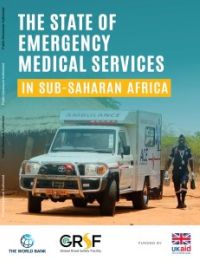
An evaluation of the various Emergency Medical Services (EMS) models and mechanisms in place in Sub-Saharan Africa (SSA) is critical in order to have a better understanding of what can be improved upon for effective pre-hospital and emergency care services (PECS). With grant funding provided by the World Bank’s Global Road Safety Facility (GRSF), this report aims explore the State of EMS Systems in Sub-Saharan Africa through a review of the models and mechanisms being developed across various States.
The premise of the report focuses on the fundamentals for effectively providing satisfactory treatment to those in need of urgent medical care, while also recognizing that there are multiple pathways, framed by the respective legislative, legal and regulatory enabling environments, towards a more formal and sustainable EMS model. It represents an effort to identify the major similarities and differences, as well as potential opportunities for greater coordination or collaboration, that can lead to the development of sound policy recommendations for fostering and expanding post-crash response services in the region.
High-level system information has been collected through questionnaires distributed to National Respondents in each country, for which 25 of 44 countries substantially responded as of April 2019 (collectively hereinafter referred to as SSA countries): Botswana, Burkina Faso, Burundi, Cabo Verde, Cameroon, Central African Republic, Chad, Comoros, Congo Brazzaville, Gabon, Lesotho, Liberia, Madagascar, Malawi, Mauritania, Niger, Rwanda, Senegal, Sierra Leone, Sudan, Tanzania, Togo, Uganda, Zambia and Zimbabwe. Missing data and discrepancies triggered a detailed review of laws and other regulatory acts, policy and plan.
The Report does not consider the advantages and disadvantages for the EMS models adopted by SSA countries, nor does it take a position on which regulatory approach should be applied, or measure the degree of EMS standards implementation and the success or failure of implementing various EMS policies. The principal aim of this report is to capture the current range of the standards and regulations in key areas of EMS systems across SSA.
The State of Emergency Medical Services in Sub-Saharan Africa is supported by UK Aid through the World Bank’s Global Road Safety Facility.

The World Bank estimates a significant funding gap in road safety of 260 billion to achieve SDG 3.6 and 11.2 in the next ten years, and recognizes that this gap cannot be closed through public funding alone and thus mobilization of private capital is required. The impacts of road traffic crashes reach far into the economy and can cost L/MICs as much as 6% of their GDP. The costs of a road traffic crash do not end at the roadside; they create ripple effects throughout the wider economy. Loss of income, property damage, insurance premiums, loss of taxes, and burdens on the health sector are just some of the far-reaching costs associated with road traffic crashes. Road traffic crashes can cost countries as much as 6 percent of their GDP and trap families in poverty as they lose income generating potential and focus on providing lifetime care.
This report examines the potential for private capital mobilization to close this gap. The report investigates the market failure to appropriately account for the cost of road crashes, which prevents private capital from flowing to road safety investments. The growth of socially responsible investing and the sustainable finance market offers a new opportunity to address this market failure. The report proposes different business models and financing instruments to channel private investment into road safety projects. These investment structures consist of subnational, public-private partnerships (PPPs) and corporate investments that can leverage the growing sustainable finance market, including social and sustainability-linked financings (SLFs).
The report also develops indicators that can be used to tie the cost of financing to the attainment of road safety targets, incentivizing borrowers to commit to road safety as part of SLFs. The report examines the enabling environment for structuring investable road safety projects in a sample of countries, looking at the barriers and opportunities, and proposing risks and mitigation strategies, like blended finance mechanisms and stable revenue sources, for long-term sustainability of road safety investments.

What is the real cost of speeding on people and the environment? These 6 graphs tell the story ⌵︎
The impacts of speed on the safety of road users, on congestion, on pollution, and on total costs of road travel are broadly misunderstood: often based on wrong assumptions, with effects taken as self-evident, failure to consider multiple impacts, externalization of costs by many stakeholders, and under-estimation of impacts (especially economic costs of higher speeds). The purpose of this brief note is to provide information on these relationships relevant to fundamental road transport policies, design, and operation. Well-established evidence shows the importance of managing travel speeds for road safety, for efficiency, for improved inclusion, and for greenhouse gas (GHG) and other emissions. Thus, speed management is a strong policy lever for the breadth of issues which must be addressed for sustainable mobility.
Reduced speeds of travel represent a major, yet under-appreciated, opportunity to improve safety, climate change impacts of travel, health, inclusion, the economy, and in some circumstances, congestion. Speed management can be achieved through a range of interventions including road infrastructure and vehicle technology, as well as enforcement and promotion.
The six graphs presented in this note tell a powerful story, across the range of these benefits of speed management.
This publication is also available in:


